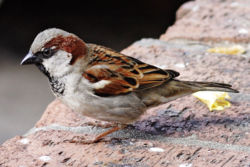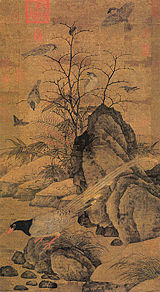Sparrow
2008/9 Schools Wikipedia Selection. Related subjects: Birds
| Old World sparrows | ||||||||||||
|---|---|---|---|---|---|---|---|---|---|---|---|---|
 |
||||||||||||
| Scientific classification | ||||||||||||
|
||||||||||||
| Genera | ||||||||||||
|
Passer |
The "true sparrows", the Old World sparrows in the family Passeridae, are small passerine birds. Generally, sparrows tend to be small, plump brown-grey birds with short tails and stubby yet powerful beaks. The differences between sparrow species can be subtle. They are primarily seed-eaters, though they also consume small insects. A few species scavenge for food around cities and, like gulls or pigeons, will happily eat virtually anything in small quantities. This family ranges in size from the Chestnut Sparrow (Passer eminibey), at 11.4 cm (4.5 inches) and 13.4 g., to the Parrot-billed Sparrow (Passer gongonensis), at 18 cm (7 inches) and 42 g. (1.5 oz). Sparrows are physically similar to other seed-eating birds, such as finches, but have a vestigial dorsal outer primary feather and an extra bone in the tongue.
The Old World true sparrows are found indigenously in Europe, Africa and Asia. In Australia and the Americas, early settlers imported some species which quickly naturalised, particularly in urban and degraded areas. House Sparrows, for example, are now found throughout North America, in every state of Australia except Western Australia, and over much of the heavily populated parts of South America.
Some authorities also classify the closely related estrildid finches of the equatorial regions and Australasia as members of the Passeridae. Like the true sparrows, the estrildid finches are small, gregarious and often colonial seed-eaters with short, thick, but pointed bills. They are broadly similar in structure and habits, but tend to be very colourful and vary greatly in their plumage. About 140 species are native to the old world tropics and Australasia. Most taxonomic schemes list the estrildid finches as the separate family Estrildidae, leaving just the true sparrows in Passeridae.
American sparrows, or New World sparrows, are not closely related to the true sparrows, despite some physical resemblance, such as the seed-eater's bill and frequently well-marked heads. They are in the family Emberizidae.
The Hedge Sparrow or Dunnock (Prunella modularis) is similarly unrelated. It is a sparrow in name only, a relic of the old practice of calling any small bird a "sparrow".
There are 35 species of Old World sparrows. Below is the full list.
Species list in taxonomic order
- Passer, the true sparrows
- Saxaul Sparrow, Passer ammodendri
- House Sparrow, Passer domesticus
- Spanish Sparrow, Passer hispaniolensis
- Sind Sparrow, Passer pyrrhonotus
- Somali Sparrow, Passer castanopterus
- Cinnamon Sparrow or Russet Sparrow, Passer rutilans
- Pegu Sparrow or Plain-backed Sparrow, Passer flaveolus
- Dead Sea Sparrow, Passer moabiticus
- Rufous Sparrow, Passer motitensis
- Socotra Sparrow, Passer insularis
- Iago Sparrow or Cape Verde Sparrow, Passer iagoensis
- Cape Sparrow or Mossie, Passer melanurus
- Grey-headed Sparrow, Passer griseus
- Swainson's Sparrow, Passer swainsonii
- Parrot-billed Sparrow, Passer gongonensis
- Swahili Sparrow, Passer suahelicus
- Southern Grey-headed Sparrow, Passer diffusus
- Desert Sparrow, Passer simplex
- Tree Sparrow, Passer montanus
- Sudan Golden Sparrow, Passer luteus
- Arabian Golden Sparrow, Passer euchlorus
- Chestnut Sparrow, Passer eminibey
- Italian Sparrow, Passer italiae
- Kenya Rufous Sparrow, Passer rufocinctus
- Kordofan Rufous Sparrow, Passer cordofanicus
- Shelley's Rufous Sparrow, Passer shelleyi
- Asian Desert Sparrow, Passer zarudnyi
- Petronia, the rock sparrows
- Yellow-spotted Petronia, Petronia pyrgita
- Chestnut-shouldered Petronia, Petronia xanthocollis
- Yellow-throated Petronia, Petronia superciliaris
- Bush Petronia, Petronia dentata
- Rock Sparrow, Petronia petronia
- Carpospiza, Pale Rockfinch
- Pale Rockfinch, Carpospiza brachydactyla
- Montifringilla, the snowfinches
- White-winged Snowfinch, Montifringilla nivalis
- Black-winged Snowfinch, Montifringilla adamsi
- White-rumped Snowfinch, Montifringilla taczanowskii
- Père David's Snowfinch, Montifringilla davidiana
- Rufous-necked Snowfinch, Montifringilla ruficollis
- Blanford's Snowfinch, Montifringilla blanfordi
- Afghan Snowfinch, Montifringilla theresae
- Tibetan Snowfinch, Montifringilla henrici
Sparrows in literature
References to Old World sparrows in literature usually refer to the House Sparrow.

- The Greek poet Sappho, in her "Hymn to Aphrodite", pictures the goddess's chariot as drawn by sparrows.
- The Roman poet Catullus addresses one of his odes to his lover Lesbia's pet sparrow ( ‘Passer, deliciae meae puellae...’), and writes an elegy on its death ( ‘Lugete, o Veneres Cupidinesque...’). The sparrow's playful erotic intimacy with its mistress ('To whose seeking she often gives her first finger/And provokes sharp pecks') makes the poet envious. At the climax of its elegy he reproaches it for dying, and distressing her ('Now, by your deeds, my girl's/Little eyes are slightly swollen and red from weeping'). The diminutiveness of the sparrow, and the hugeness and eternity of the afterlife, form a bathos that is typical of the mock elegy form: ‘qui nunc it per iter tenebricosum/illuc unde negant redire quemquam’ ('He now goes on a journey through that gloomy place,/From where they say no one returns'). The sparrow's hopping is represented metrically.
- In the New Testament, Jesus reassures his followers that not even a sparrow can fall without God's notice, and that their own more significant suffering is certainly seen and potentially forestalled or redeemed by God. ( Luke 12:6; Matthew 10:29.)
- The Venerable Bede's (8th c.)"sparrow in the hall" episode describes the moment of transition between Anglo-Saxon pagan and Christian eras. Ecclesiastical History of the English Church And People
- In Phyllyp Sparowe (pub. c. 1505), by the English poet John Skelton, Jane Scrope's laments for her dead sparrow are mixed with antiphonal Latin liturgy from the Office of the Dead. It belongs to the same tradition as Catullus' poem, or Ovid's lament for a parrot in the Amores: 'And on me it wolde lepe/Whan I was aslepe,/And his fethers shake,/Wherewith he wolde make/Me often for to wake/And for to take him in/Upon my naked skyn'.
- In the Redwall series of fantasy novels, sparrows are somewhat important to the plot. They are portrayed as fierce fighters; the main sparrow character is Warbeak.
- Hamlet, by William Shakespeare, as Hamlet faces his tragic fate. he says, " There's a special providence in the fall of a sparrow", presumably referencing the New Testament quote shown above.
- Masaoka Shiki`s haiku: "The sparrow hops along the veranda, with wet feet."
